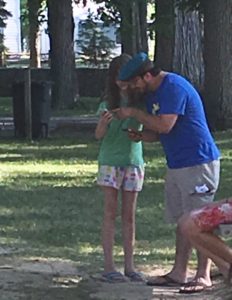An opinion piece by ELIZABETH ROBERTS-ZIBBEL
Just a few days after the now infamous app Pokémon Go was released, after we had finally broken through the frustratingly busy servers, I took both girls on a Pokémon-catching journey to City Park. They got out and ran toward the playground, clutching their devices. I immediately spotted another player and watched from the car, curious about whether they would cross paths with him. He was a large young man with a buzz cut and a sleeveless t-shirt, his arms covered with tattoos. He paused, looked up from his phone and smiled at my daughters, and Alexandra brushed her hair out of her face and said something to him. Excitedly, she held up her phone and the man nodded, pointing into the distance, and Isobel began jumping up and down, they chatted some more, and then went their separate ways. I got out and sat down on a bench, and as Alexandra walked around Isobel handed me her tablet and went to play in the sandbox. Soon Alexandra decided, on her own, to approach a group of several other young adult Pokémon Goers, and they conferred for a while. She ran over to me. “There are so many people playing this game! It’s so much fun to talk to everyone!” This, my shy girl who has a hard time even talking to people she knows sometimes. She went over to the sandbox to join Isobel, and there was another pair obviously playing nearby; she began talking to them too. I heard the man exclaim, “You got a Lickitung? Where did you find that?” Sand Ridge Road, I heard her reply, and he said to the woman with him, “We have to check out Sand Ridge Road!”

For those who don’t know, Pokémon Go is an augmented reality game that uses a device’s camera and location services to place Pokémon into players’ actual environments, which they can then catch by tossing a red and white PokéBall at them. Users see their human avatar and a map on the screen, and get alerts when Pokémon are nearby. When one gets close enough, the map disappears and is replaced by what would be seen through the cell phone camera, but with a Pokémon placed over it which can then be caught through interaction with the screen. PokéStops are locations (parks, monuments, churches, other public buildings) where PokéBalls can be refilled, and other items like eggs and potions can be collected. Once a certain level is reached, there is a choice of three teams to join, and caught Pokémon can be transferred, evolved, and used to battle against other players in Gyms which tend to be larger landmarks.
First, it was reported that more people had downloaded Pokémon Go than the dating app Tinder. Then, it had more daily users than Twitter on some platforms. “Cops and kids are playing Pokémon Go together in the streets, local businesses are tailoring their marketing around Pokémon Go, and self-professed socially awkward gamers are making new friends by the dozen. Walk around any neighborhood in America, and it’s clear that Pokémon Go is enormously popular and having a massive social impact. How massive, though? Data published today by SimilarWeb indicates that the mobile game may be poised to surpass Twitter in daily active users on Android (Jason Evangelho, Forbes, 7/10/16).”
Soon afterward, the backlash began, perhaps inevitable whenever anything is so overwhelmingly popular. People were lost in the augmented reality on their phones, wandering into traffic. Others seemed extremely concerned about the data being collected by Niantic, the creator of the app. Pokémon were being caught in the Holocaust Museum and other traditionally solemn, highly inappropriate places.
But stories like this one about Max began circulating as well. I saw it first when a friend shared a wonderful post originally written by Lenore, the mother of a young boy with autism, and Max’s Pokémon Go success has since gone viral. “MY AUTISTIC CHILD IS SOCIALIZING,” Lenore wrote. “Talking to people. Smiling at people. Verbalizing. Participating in pragmatic speech. With total strangers. Looking up at them. Sometimes even in the eye. Laughing with them. Sharing something in common. This is AMAZING.”
Over the weekend after play practice on campus, Alexandra told me that the BGSU Library Mural is a PokéStop. We drove there and parked, and approached the tables on the concrete pavilion where a couple was sitting with their phones, perhaps playing Pokémon Go. (“Pokémon Paranoia: The suspicion that anyone on their phone outdoors is playing PoGo.” – Urban Dictionary.) We moved down into the grass and Alexandra continued looking for and catching Pokémon while Isobel did cartwheels. Approaching the clock tower, we began to see more and more groups of young adults, devices out, chatting and pointing. One group of people had a little dog, and Isobel approached and asked if she could pet it. Alexandra said to me, “There was a Pikachu around here somewhere!” The dog’s owner smiled told her their friend had caught one on the other side of the Education Building, so we moved on. Or, Isobel and I looked at each other and followed Alexandra as she bounded excitedly away, phone in hand. We petted more dogs, smiled and waved at roaming, Pokémon-catching students on bikes and skateboards. Alexandra didn’t locate the Pikachu, but she did find a Growlithe, exciting as it is classified as uncommon. Walking back past the clock tower, Alexandra said “Oh wait, there’s supposed to be a Sandshrew!” Someone sitting on a nearby bench called out to her, told her exactly where it was, and wished her luck.
Stories circulated that criminals were using the app to attract unassuming players in order to steal from them. A teenager in the process of capturing a Pokémon found a dead body instead. Someone trying to drive and catch Pokémon at the same time slammed into a parked police car; locally, a couple people scaled the walls of The Toledo Zoo to catch a Pokémon after hours and were arrested – there will always be those lacking in common sense. A few in my own Facebook feed just seemed irritated that a huge portion of the world’s population were having collective fun doing something that they themselves were not interested in.
The night after the sniper shooting of police officers at a protest in Dallas, I had picked Alexandra up from her volunteer shift at the library and we were driving home the long way, looking for a common, but still uncaught, Eevee. Turning onto Wintergarden Road, I thought about another post I’d read on Facebook (originally on Tumblr) about a man playing Pokémon Go at 3 a.m. in a neighborhood playground, who suddenly noticed two other guys sitting on a bench with their phones. “Yo man! You playing Pokémon Go?” They were standing together conferring about which team to join when a police car pulled up. The post went on: “So it turns out two twentysomething black dudes and a forty year old white guy chilling in the park at 3 a.m. looks pretty suspicious. It took a bit of talking to convince the cop we weren’t doing a drug deal, and a bit longer to explain the game. Then the cop downloaded the app and asked us how to get started.” The point of the post being that Pokémon Go is something that can unite us during a time of unparalleled division in the world. It can help people exercise, talk to each other, get up off the couch and out of their homes.
Besides which, it’s fun. And there’s nothing wrong with that.





